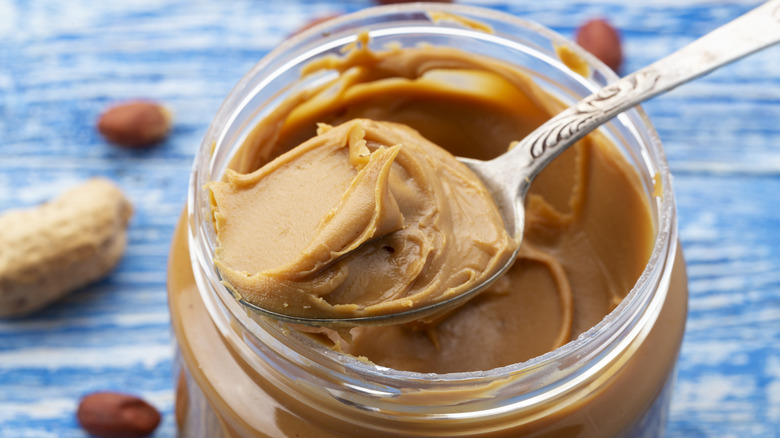Can Peanut Butter Actually Replace Butter In Any Recipe?
What can you do with peanut butter? You can probably make a pretty mean peanut butter and jelly sandwich. You can make some homemade peanut butter cookies. Or, if you're feeling like it, just eat peanut butter right off the spoon for a quick snack.
Of course, while peanut butter can't be used in each and every dish, to say that peanut butter doesn't have its own uses outside of sandwiches and cookies wouldn't be true. If you're out of shaving cream, for example, you can actually use smooth peanut butter as a natural substitute, as its texture and oils make it not just thick enough to keep the razor from cutting you but also help moisturize your skin. If you have gum stuck in your hair (for reasons you probably don't want to admit), use a spoonful of peanut butter to work the gum out of your locks.
But have you ever wondered if it's possible to substitute peanut butter for butter and vice-versa? Obviously not, you're probably thinking. "You can't just use peanut butter as a butter substitute merely because it has the word 'butter' in its name." That would be like substituting vegetable oil for motor oil when working on your car just because it has "oil" in the name, right? As it turns out, it's not only perfectly acceptable to include peanut butter in some dishes, but your dishes might also benefit from it.
Peanut butter can be substituted for butter
Let's say that you're making brownies or a cake and, right when you reach to grab a stick of butter, you find that it's all gone. But, in the cabinet next to the butter dish, is an inconspicuous jar of JIF Peanut Butter. For a split second, you wonder if you can use peanut butter as a substitute for regular butter.
It actually is possible to use peanut butter as a substitute — so long as you follow a simple ratio. You can't just scoop a few spoonfuls of peanut butter into the bowl and go on with the recipe. A good rule of thumb for utilizing peanut butter as a butter replacement is to use a 50/50 mix of peanut butter and oil (vegetable, canola, etc.) for the amount of butter listed. For example, if you're supposed to include a cup of butter, you'll need four fluid ounces of peanut butter and four fluid ounces of your choice of oil to substitute.
What is the end result of baking with peanut butter instead of butter? The taste of the finished product will have a nuttier texture, but it will also be much denser and heavier rather than light and moist. If you prefer your baked goods like cakes or brownies to be moist rather than heavy, consider skipping the peanut butter. If you don't mind it, then experiment with peanut butter as much as you'd like.
Peanut butter can also be used as a sauce
Although peanut butter may be a good butter substitute for cookies, cake, or baked goods, you may not be willing to try it out on more dinner-friendly items. And while it might not be a good idea to fry up salmon or a good steak in peanut butter because you finished off your last stick of butter, peanut butter — or at least a variant of peanut butter — can be turned to for some dishes, such as Thai or Eastern cuisine.
You may have had Chinese or Thai food that's served with "peanut sauce." This peanut sauce may taste like a sweeter, if a little spicy, version of peanut butter and is usually served on noodles, pasta dishes, or alongside egg rolls. A basic recipe for peanut sauce includes peanut butter, tamari or soy sauce, maple syrup, red Thai chili, and lime juice. These ingredients, when combined, form a thick, but pourable sauce ideal for drizzling or dipping. You can also roadtest different types of nut butter, like almond or cashew butter, though the saltiness of the peanut butter better complements the savoriness of Thai cuisine.
You could also prepare a thicker, more dessert-friendly peanut butter sauce out of peanut butter, heavy whipping cream, molasses or corn syrup, and brown sugar. This is ideal for ice creams or cake– or, just like regular peanut butter, is delicious when eaten directly with a spoon.


